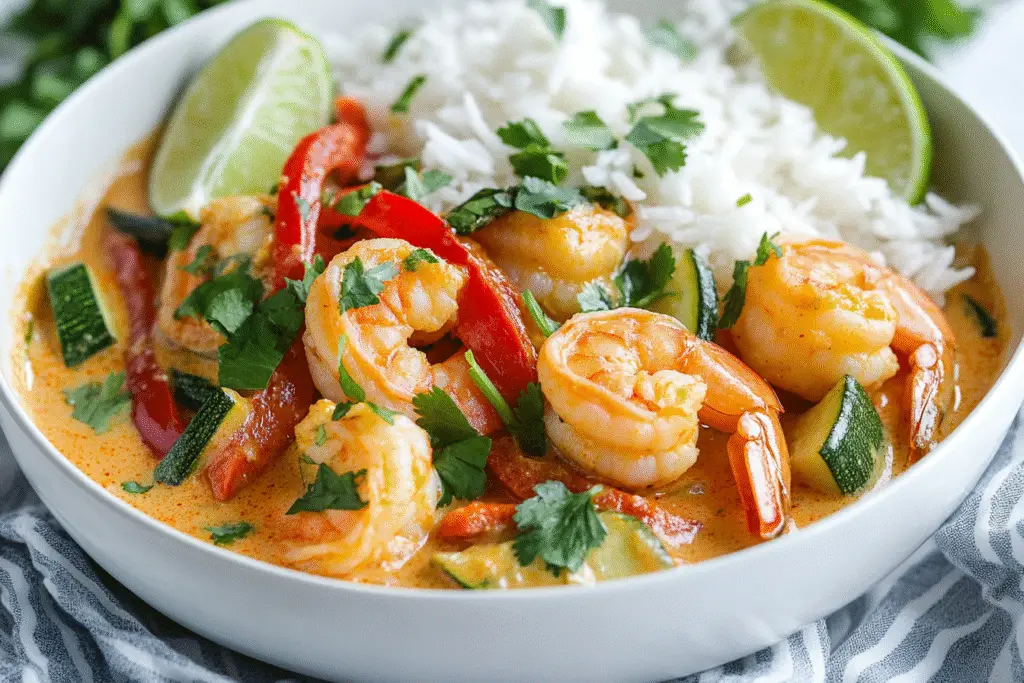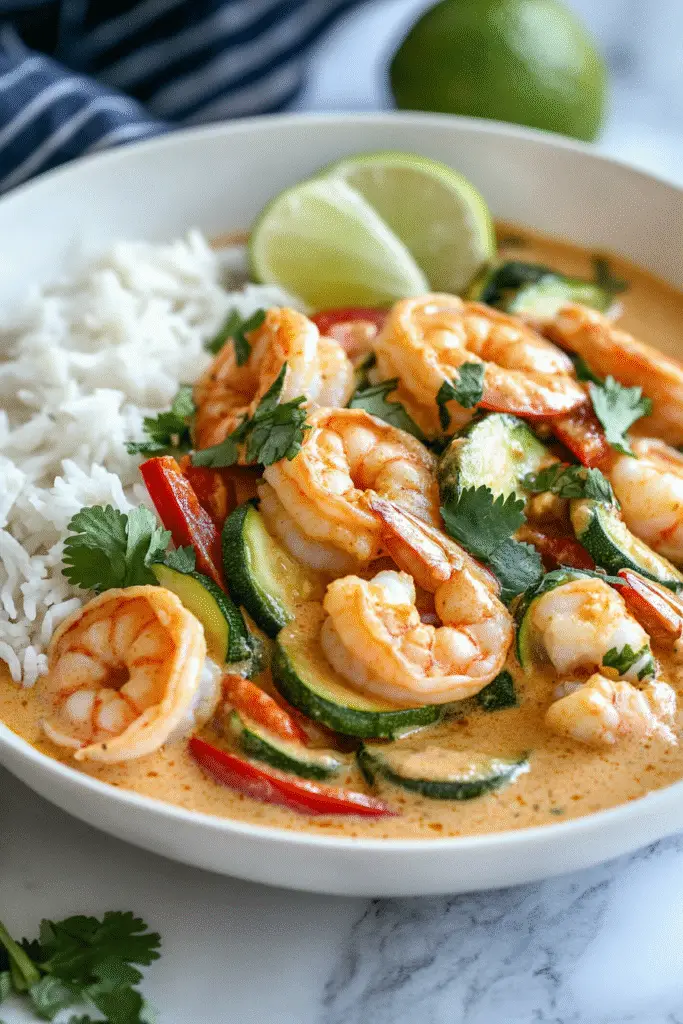Thai coconut shrimp curry is a rich, aromatic, and deeply satisfying dish that combines tender shrimp with a creamy coconut milk base, fragrant Thai red curry paste, fresh herbs, and vibrant vegetables. It’s a perfect balance of sweet, spicy, salty, and tangy flavors, and it’s surprisingly quick to prepare, making it ideal for weeknight dinners or when you’re craving Thai takeout at home.
Unlike heavy Western-style curries, Thai coconut shrimp curry is lighter and more aromatic, thanks to ingredients like lemongrass, kaffir lime leaves, fish sauce, and fresh lime juice. The shrimp cook quickly in the gently simmering coconut broth, absorbing layers of flavor without becoming overcooked.
In this step-by-step Thai Coconut Shrimp Curry Recipe, I’ll walk you through selecting the right curry paste, balancing flavors, troubleshooting common issues, and offering flexible variations so you can adjust the spice and ingredients to your taste.
Why Thai Coconut Shrimp Curry Can Go Wrong: Common Pitfalls and How to Avoid Them
Even though this curry is relatively simple, the success of the dish hinges on timing, ingredient quality, and balancing key flavors.
Common Mistakes:
- Overcooked shrimp: Shrimp can quickly turn rubbery if cooked too long.
- Broken or greasy curry: Happens when coconut milk is boiled too hard or the curry paste isn’t cooked properly.
- Bland curry: Occurs if the curry paste is under-sautéed or if it’s not balanced with enough salt, acid, or sweetness.
- Overpowering spice: Thai curry can easily become too spicy without cooling or balancing elements.
Keys to Success:
- Cook shrimp at the very end just until pink.
- Sauté curry paste in oil before adding coconut milk to release full flavor.
- Balance salty (fish sauce), sweet (sugar), sour (lime juice), and spicy (curry paste) elements.
- Simmer gently to maintain a creamy, cohesive sauce.

Choosing the Best Ingredients for Thai Coconut Shrimp Curry
Shrimp
- Medium to large shrimp (16-30 count per pound) are ideal.
- Fresh or thawed frozen shrimp, peeled and deveined.
- Pat shrimp dry to prevent watering down the curry.
Curry Paste
- Thai red curry paste is traditional, but yellow or green curry paste can be substituted.
- Authentic Thai brands like Maesri or Mae Ploy provide the best flavor.
Coconut Milk
- Full-fat coconut milk creates a rich, creamy sauce.
- Avoid light coconut milk, which can lead to a thin, watery curry.
Vegetables
- Bell peppers, zucchini, snap peas, and baby corn are great choices.
- Fresh Thai basil and cilantro add herbaceous notes.
Seasonings
- Fish sauce provides essential saltiness and umami.
- Brown sugar or palm sugar balances the heat.
- Fresh lime juice adds acidity and brightness.
Essential Equipment
- Large skillet or wok: For quick, even cooking.
- Mixing spoon or spatula: For stirring curry paste and sauce.
- Citrus juicer: For fresh lime juice.
If you like to cook Thai food regularly, a mortar and pestle can help grind your own curry pastes for future recipes.

Smart Preparation Tips
Preparation Timeline:
- Active prep: ~15 minutes
- Cooking: ~15 minutes
Prep Checklist:
- Peel and devein shrimp ahead of time.
- Chop vegetables and herbs before starting for smooth cooking flow.
- Open coconut milk and have curry paste measured out before heating the pan.
Flavor Variations and Customizations
- Spicy Version: Add fresh Thai bird’s eye chilies or increase curry paste.
- Mild Version: Use less curry paste and add extra coconut milk.
- Add Noodles: Serve over rice noodles instead of rice for a Thai-style noodle bowl.
- Vegetarian Version: Substitute shrimp with tofu and add extra vegetables.
Common Mistakes and How to Fix Them
- Shrimp overcooked: Always add shrimp at the very end and cook just until pink.
- Coconut milk separates: Simmer gently; don’t boil vigorously.
- Unbalanced flavor: Adjust fish sauce, sugar, and lime juice carefully to achieve harmony.
- Too spicy: Add more coconut milk or a little sugar to mellow the heat.
Storage, Freezing, and Reheating Tips
- Storage: Store in an airtight container in the fridge for up to 2 days.
- Freezing: Not recommended; coconut milk can separate and shrimp lose texture when frozen.
- Reheating: Reheat gently over low heat. Avoid boiling to preserve shrimp texture and sauce consistency.
Thai Coconut Shrimp Curry Recipe
Ingredients
For the Curry:
- 1 tablespoon vegetable oil
- 3 tablespoons Thai red curry paste
- 1 can (14 ounces) full-fat coconut milk
- ½ cup chicken broth or water
- 1 tablespoon fish sauce
- 1 teaspoon brown sugar
- 1 red bell pepper, thinly sliced
- 1 zucchini, sliced
- 1 pound medium shrimp, peeled and deveined
- Juice of 1 lime
- Fresh Thai basil or cilantro, for garnish
For Serving:
- Steamed jasmine rice
- Lime wedges
- Optional: Red chili slices for extra heat
Step-by-Step Instructions
Step 1: Sauté the Curry Paste
- Heat vegetable oil in a large skillet or wok over medium heat.
- Add Thai red curry paste and sauté for 1-2 minutes until fragrant and slightly darkened.
Step 2: Build the Sauce
- Stir in coconut milk, chicken broth, fish sauce, and brown sugar.
- Bring to a gentle simmer and cook for 3-4 minutes to allow flavors to meld.
Step 3: Add Vegetables
- Add sliced bell pepper and zucchini.
- Simmer for 3-4 minutes until vegetables are tender but still crisp.
Step 4: Cook the Shrimp
- Add shrimp and simmer gently for 2-3 minutes until shrimp are pink and just cooked through.
Step 5: Finish the Curry
- Remove from heat and stir in fresh lime juice.
- Taste and adjust seasoning with more fish sauce, sugar, or lime juice as needed.
Step 6: Serve
- Serve over steamed jasmine rice.
- Garnish with fresh Thai basil or cilantro and lime wedges.
- Optionally, top with sliced fresh chilies for extra heat.
Serving Suggestions
- With Jasmine Rice: Classic Thai accompaniment.
- With Rice Noodles: Creates a curry noodle bowl.
- With Cucumber Salad: Adds a cooling, crunchy contrast.
- With Grilled Vegetables: Complements the creamy curry sauce.
Thai Coconut Shrimp Curry Variations: Classic vs. Spicy vs. Noodle Bowl
| Feature | Classic Thai Shrimp Curry | Spicy Thai Shrimp Curry | Thai Shrimp Noodle Bowl |
|---|---|---|---|
| Heat Level | Mild to medium | Medium to hot | Mild to medium |
| Key Additions | Bell peppers, zucchini | Extra chilies, more curry paste | Rice noodles, extra broth |
| Serving Style | Jasmine rice | Jasmine rice, chili garnish | Rice noodles, extra lime |
FAQs and Troubleshooting
Can I use green or yellow curry paste?
Yes, both work well—green is typically spicier and more herbaceous.
Can I use light coconut milk?
You can, but the curry will be less rich and more watery.
Can I substitute chicken or tofu?
Yes, both make excellent alternatives.
How do I adjust the spice level?
Use less curry paste for milder curry or more coconut milk to soften heat.
Can I make this ahead?
You can prepare the sauce and vegetables in advance, but cook shrimp just before serving.
Final Thoughts
Thai coconut shrimp curry is a fragrant, creamy, and soul-satisfying dish that captures the complexity of Thai cuisine in a simple, weeknight-friendly recipe. The combination of tender shrimp, silky coconut milk, vibrant curry paste, and fresh herbs makes every spoonful a delicious balance of sweet, spicy, salty, and tangy.
This detailed recipe ensures you’ll achieve perfect shrimp texture, balanced sauce, and aromatic Thai flavors every time, whether you keep it classic, spice it up, or customize it with your favorite vegetables and noodles. It’s a cozy, flexible dish you’ll want to return to again and again.
